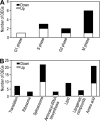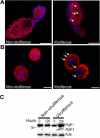Global analysis of the transcriptional response of whitefly to tomato yellow leaf curl China virus reveals the relationship of coevolved adaptations
- PMID: 21270146
- PMCID: PMC3067855
- DOI: 10.1128/JVI.02507-10
Global analysis of the transcriptional response of whitefly to tomato yellow leaf curl China virus reveals the relationship of coevolved adaptations
Abstract
The begomoviruses are the largest and most economically important group of plant viruses transmitted exclusively by the whitefly Bemisia tabaci in a circulative, persistent manner. The circulation of the viruses within the insect vectors involves complex interactions between virus and vector components; however, the molecular mechanisms of these interactions remain largely unknown. Here we investigated the transcriptional response of the invasive B. tabaci Middle East-Asia Minor 1 species to Tomato yellow leaf curl China virus (TYLCCNV) using Illumina sequencing technology. Results showed that 1,606 genes involved in 157 biochemical pathways were differentially expressed in the viruliferous whiteflies. Kyoto Encyclopedia of Genes and Genomes (KEGG) pathway analysis indicated that TYLCCNV can perturb the cell cycle and primary metabolism in the whitefly, which explains the negative effect of this virus on the longevity and fecundity of B. tabaci. Our data also demonstrated that TYLCCNV can activate whitefly immune responses, such as autophagy and antimicrobial peptide production, which might lead to a gradual decrease of viral particles within the body of the viruliferous whitefly. Furthermore, PCR results showed that TYLCCNV can invade the ovary and fat body tissues of the whitefly, and Lysotracker and Western blot analyses revealed that the invasion of TYLCCNV induced autophagy in both the ovary and fat body tissues. Surprisingly, TYLCCNV also suppressed the whitefly immune responses by downregulating the expression of genes involved in Toll-like signaling and mitogen-activated protein kinase (MAPK) pathways. Taken together, these results reveal the relationship of coevolved adaptations between begomoviruses and whiteflies and will provide a road map for future investigations into the complex interactions between plant viruses and their insect vectors.
Figures







References
-
- Audic, S., and J. M. Claverie. 1997. The significance of digital gene expression profiles. Genome Res. 7:986-995. - PubMed
-
- Bochtler, M., L. Ditzel, M. Groll, C. Hartmann, and R. Huber. 1999. The proteasome. Annu. Rev. Biophys. Biomol. Struct. 28:295-317. - PubMed
-
- Brault, V., et al. 2010. Transcriptomic analysis of intestinal genes following acquisition of pea enation mosaic virus by the pea aphid Acyrthosiphon pisum. J. Gen. Virol. 91:802-808. - PubMed
Publication types
MeSH terms
LinkOut - more resources
Full Text Sources
Molecular Biology Databases

